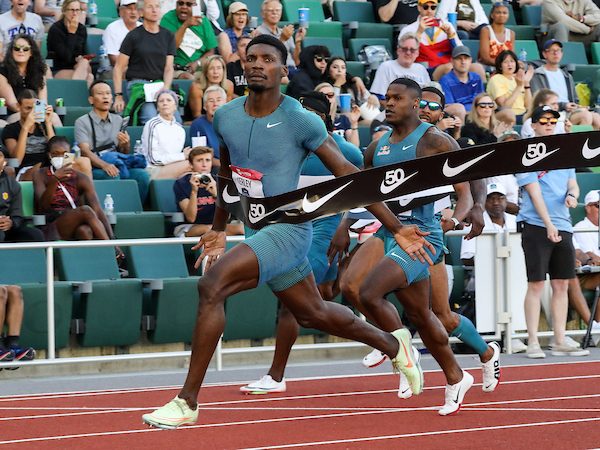Stuart had wanted to submit this last week, but we were launching the new RunBlogRun site. So, Stuart Weir, our European senior editor, updated his piece, and presto! Fred Kerley is here!
Fred Kerley excited for 2022
You know how you have the perfect idea for an interview and the athlete goes and spoils it! I was going to get the exclusive from Fred Kerley on why he had given up the 400m to concentrate on the 100.
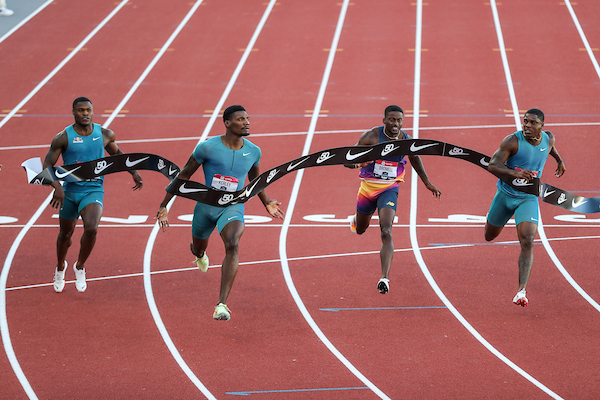
“I haven’t switched from the 400”, he told me! “I’m still training for the 400. I was training for the 400 all through the Olympics. I wasn’t focusing on speed work, just on competitiveness. It was just me going on my heart, going and running. I am a competitor and I like to compete. There is a difference between people who just want to get in a race and do nothing. No one in this world will break my confidence. I believe in myself and that’s a hard man to beat. I haven’t changed from 400 to 100. I asked my coach and my agent, the day before the Olympic trials saying I’d like to run the 100 and 200. It was the day before the entries closed. I was coming back from the FBK games where I had run 44.74 and I said to my coach and agent, ‘I think my best move right now would be the100 and 200’. And they said to me, ‘if you believe in yourself, go for it’.
Growing up in Texas, Fred Kerley was more into football and basketball than track and field. We have his High School coach – Coach Lowe – to thank for his emergence as a track star. But Fred’s motives were not entirely pure: “I was just doing track and field for fun and to make me faster for football”. Then an accident pushed him in our direction. “In my senior year in high school, I broke my collarbone and felt I shouldn’t play football in college because it would just lead to more injuries”. At high school, he had done a range of disciples – triple jump, long jump, and a few high jumps but his main event was 200m in which he ran a ran 21.5. While he ran some 4 by 400s, he thinks he only ran one individual 400 in his high school career “and that was just for fun”. When asked how good he was as a jumper, he replied: “I was decent, decent” adding, “I won’t be doing any more jumping any time soon. I think jumping takes a lot out of you. Jumping is harder than running. I need my knees and ankles”.
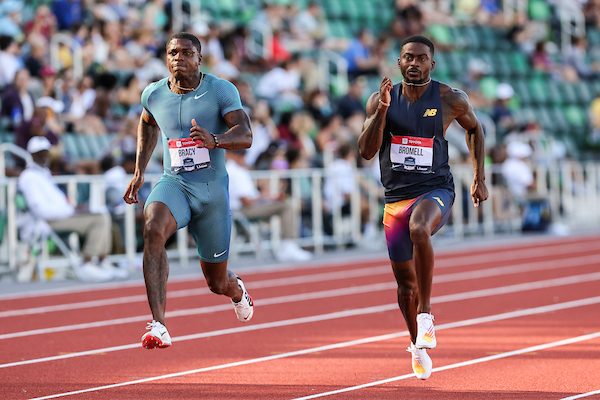
USATF Outdoor Track & Field Championships held at Hayward Field, University of Oregon, June 23-26, 2022, photo by Kevin Morris
Gradually a talent for running emerged, helped by a college coach seeing that 400 might be his best event: “I went to South Plains College and I ran 46.38 (2014) but then in my sophomore year I tore my quad. I got a scholarship to A&M and I ran 45.1 and then a 44 at NCAA. The following year I dropped the bomb and ran 43.70”. [ 43.70 in Austin, May 2017].
In 2019 he took bronze in the World Championships in Doha, running 44.17 behind Steven Gardiner and Antony Zambrano. He was excited for the 2020 Olympics, came through the winter in good shape, ready to attack the 2020 season, and in a phrase he used more than once in the interview, ready to “do some damage”. Then the pandemic struck. His local track closed. Meets were canceled and the Olympics postponed.
Then in 2021, he switched to 100m – but he didn’t really. He told me that he had not switched from 400 to 100 and assured me that in 2022 we would see him running 100s, 200s, and 400s – but not on the same day! Going into the 2021 US Olympic Trials, he had one goal – to be selected for his first Olympic Games. He “wasn’t healthy”. Carrying an injury, which was hampering his bend running, led him to the conclusion that his most effective races in the trials would be the 100 and 200. He ran 9.78 to take second place in the trials and guarantee his ticket to Tokyo. He also ran the 200 in 19.90 – a time which would have placed him fourth in the Olympic Final but which, unfortunately, also placed him fourth in the US trials. Andre de Grasse won the Olympic 200m final with the three Americans who had finished ahead of Fred in the trials coming second, third and fourth.
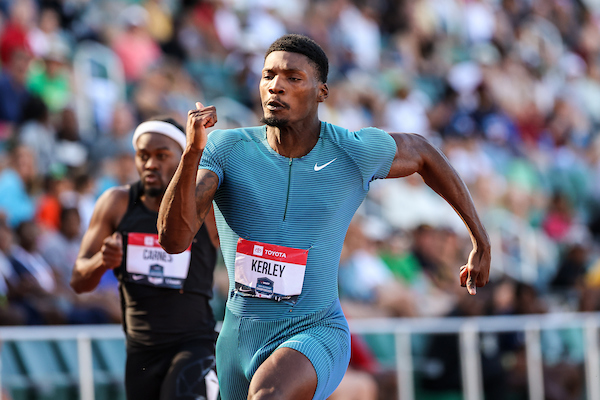
USATF Outdoor Track and Field Championships held at Hayward Field, University of Oregon, June 23-26, 2022, photo by Kevin Morris
He continued his excellent form after the Olympics, running sub 10 seconds for 100m eleven times in the season as well as five sub 20 finishes in the 200. He won the Diamond League 100m in 9.87. It’s a nice story that he had never run a 100m race before and suddenly was winning an Olympic silver medal, but as he pointed out to me, he had run a 10.56 aged 18 and had been in lots of sprint relays in college.
Having competed in World Championships in London and Doha, he is delighted to have a home championship and on a track, he knows well. He decided not to do an indoor – “Outdoors is where everything comes alive”. He assured me that I would see him at many Diamond Leagues, adding “I love Europe. Europe is a blessing to me because I can travel the world and see everything that I used to just see in textbooks and see it in real life. I love traveling in Europe and seeing all the different stuff”.
His early season form has been impressive:
100m – seven races all under 10 seconds including 9.83, 9.96, and 9.77 at US Champs.
200m – Three times sub 20, including 19.75 in Doha.
400m – one race, 44.47
If he can take an Olympic silver medal in a season where he wasn’t healthy, it will be exciting to see what he can do in Oregon and beyond.
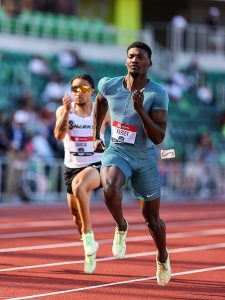
USATF Outdoor Track and Field Championships held at Hayward Field, University of Oregon, June 23-26, 2022, photo by Kevin Morris
Author

Since 2015, Stuart Weir has written for RunBlogRun. He attends about 20 events a year including all most global championships and Diamond Leagues. He enjoys finding the quirky and obscure story.
View all posts

